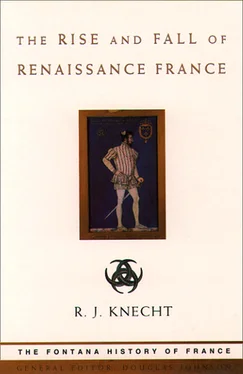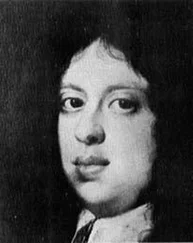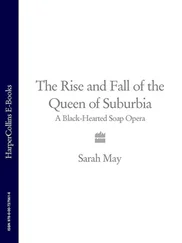Contemporaries often remarked on Francis’s eloquence and charm. He would talk easily on almost any subject, though sometimes with more self-assurance than knowledge; he could also write well. The letters he wrote to his mother during his first Italian campaign are spontaneous and vivid; his verses display emotional sincerity. But Francis was first and foremost a man of action: he delighted in hunting, jousting and dancing. Dangerously realistic mock battles capable of inflicting serious injuries were a stock entertainment at his court. In hunting, as in war, Francis showed outstanding courage. During celebrations at Amboise in June 1515 he had to be dissuaded from engaging a wild boar in single combat.
Francis has gone down in history as a great lover. Women certainly loomed large in his life, though many stories about his amours are pure fantasy. That is not to say that his morals were irreproachable. He was dissolute and had probably contracted syphilis before 1524. About the time of his accession he was having an affair with the wife of Jacques Disomme, a distinguished parlementaire. Truth, however, is not easily distilled from gossip. Even the king’s first official mistress, Françoise de Foix, comtesse de Châteaubriant, is a shadowy figure. She seems to have had little or no political influence.
Three women were pre-eminent at Francis I’s court in the early part of his reign: his mother, his sister and his wife. Louise of Savoy, being a widow in her early forties, was free to devote herself to her son’s service. She was given a powerful voice in government and her influence was felt especially in foreign affairs. The king’s sister Marguerite was intelligent, vivacious, and quite attractive. In 1509 she married Charles duc d’Alençon, but the match proved unhappy. Marguerite found consolation in pious meditation and good works. She became attracted to the ideas of Jacques Lefèvre d’Etaples, leader of an evangelical group known as the Cercle de Meaux , and wrote religious poems which offended the narrowly orthodox ‘Sorbonne’, as the Paris Faculty of Theology is commonly known. Marguerite shared her mother’s interest in public affairs; foreign ambassadors often mentioned her in their dispatches. As for Queen Claude, she was widely renowned for her sweet, charitable and pious nature. Over a period of nine years she bore the king three sons and four daughters.
The funeral of Louis XII took place at the abbey of Saint-Denis on 12 January 1515. Francis meanwhile organized his administration. Though not bound by the obligations of his predecessor, he chose to confirm many existing office-holders and privileges. On 2 January, for example, he confirmed members of the Parlement of Paris. Among members of Louis XII’s administration who were kept in office was Florimond Robertet, ‘the father of the secretaries of state’. The new reign also brought new blood into the administration. Antoine Duprat became Chancellor of France. The son of a merchant of Issoire, he had entered the law and had risen from the Parlement of Toulouse to that of Paris, becoming its First President. He gained the favour of Anne of Brittany and, after her death, joined the service of Louise of Savoy. It was doubtless with her support that he became chancellor. Duprat was hard-working and shrewd, but also ruthless and grasping. He became almost universally unpopular. Another great office that had fallen vacant was the constableship of France. Charles III duc de Bourbon, the king’s most powerful vassal, was now given the office. He had a distinguished war record, having fought bravely at Agnadello in 1509 and against the Swiss in 1513. Bourbon was also governor of Languedoc and Grand chambrier de France. The marshals of France, though subordinate to the constable, were on a par with dukes and peers. At Francis’s accession they numbered only two: Stuart d’Aubigny and Gian Giacomo Trivulzio. Francis created two more: Odet de Foix, seigneur de Lautrec, and Jacques de Chabannes, seigneur de Lapalice. On becoming marshal, Lapalice relinquished the office of Grand Master of France ( Grand maître de France ), which was given to Francis’s erstwhile governor, Artus Gouffier, seigneur de Boisy.
In distributing favours Francis did not forget his relatives and friends. He allegedly handed over to his mother all the revenues accruing from the confirmation of existing office-holders. Her county of Angoulême was raised to ducal status and she was also given the duchy of Anjou, the counties of Maine and Beaufort-en-Vallée and the barony of Amboise. Her half-brother René, ‘the great bastard of Savoy’, was appointed Grand sénéchal and governor of Provence. Francis’s brother-in-law, Charles d’Alençon, officially recognized as ‘the second person of the kingdom’, was made governor of Normandy. The house of Bourbon was also honoured: the vicomté of Châtellerault, which belonged to François, the constable’s brother, was turned into a duchy. The county of Vendôme, belonging to a second brother called Charles, was likewise elevated in status. Guillaume Gouffier, seigneur de Bonnivet, one of Francis’s childhood companions at Amboise, was appointed Admiral of France, though at this time the office did not imply service at sea.
On 25 January, Francis was crowned in Reims cathedral. Though no longer regarded as essential to the exercise of kingship, the coronation or sacre remained an important symbol of the monarchy’s supernatural quality and close alliance with the church. From Reims, Francis went first to the shrine of Saint-Marcoul at the priory of Corbeny, a pilgrimage closely connected with his thaumaturgical powers, then to the shrine of the Black Virgin at Notre-Dame de Liesse. At Saint-Denis, burial place of his royal predecessors, he confirmed the abbey’s privileges and underwent another, less elaborate, coronation. Finally, on 15 February, he made his joyful entry ( entrée joyeuse ) into Paris.
Marignano (13–14 September 1515)
By January 1515, France had lost all her Italian conquests. The house of Sforza held Milan in the person of Massimiliano Sforza, Genoa was an independent republic, and the kingdom of Naples belonged to Aragon. Francis I was expected to regain the ground lost by his immediate predecessors and to avenge the defeats recently suffered by French arms. Veterans of the Italian wars whose reputations had been dented and young noblemen anxious to show their valour looked to him for satisfaction. His youth and powerful physique seemed perfectly suited to the part they expected him to play. But before he could launch a new Italian campaign, Francis needed to neutralize his more powerful neighbours. Charles of Habsburg, a shy and unprepossessing youth of fifteen, was the son of Archduke Philip the Fair and the grandson of the Emperor Maximilian and Ferdinand of Aragon. On his father’s death in 1506 he had inherited the territories of the house of Burgundy (Franche-Comté, Luxemburg, Brabant, Flanders, Holland, Zeeland, Hainault and Artois) as well as a claim to the duchy of Burgundy, which France had annexed in 1477. A Burgundian by birth and upbringing, Charles longed to rebuild his mutilated inheritance, hoping eventually to be buried in Dijon cathedral. He was encouraged by his aunt Margaret of Savoy, who ruled the Low Countries in his name. Shortly after Francis’s coronation, ambassadors from Charles came to Compiègne with their master’s homage for Flanders and other fiefs. An alliance soon followed: under the Treaty of Paris (24 March 1515), Charles was promised the hand of Louis XII’s infant daughter Renée.
Henry VIII, king of England, a robust young man of twenty-four, was anxious not to be outshone by the new king of France, yet did not wish to pick a quarrel with him at this stage. Having recently tasted victory on the Continent, he was content to enjoy himself at home and leave policy-making to his chief minister, Thomas Wolsey. On 5 April the Anglo-French Treaty of London was given a new lease of life, Francis promising to honour his predecessor’s debt to England of one million gold écus over ten years.
Читать дальше












